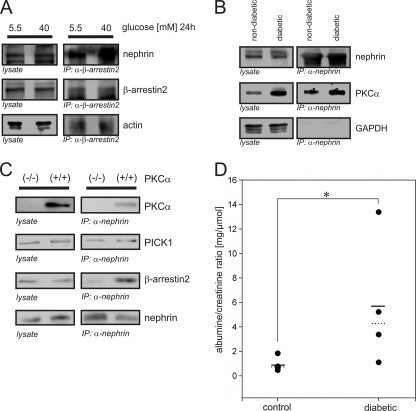FIGURE 6.
High glucose concentrations increase the β-arrestin2-nephrin interaction in vivo and cause albuminuria in mice. A–C, Western blots showing endogenous coimmunoprecipitations. A, endogenous interaction of β-arrestin2 and nephrin. Murine glomeruli (C57BL/6 mice) were incubated for 24 h after isolation in 5.5 or 40 mm glucose. β-Arrestin2 was immunoprecipitated, and the interaction was determined by staining of nephrin. Staining of actin served as the internal control. B, endogenous interaction of nephrin and PKCα. Diabetes was induced in C57BL/6 mice by injection of streptozotocin. After 24 h of glucose levels > 33 mmol/liter, glomeruli were isolated and lysed. Nephrin was immunoprecipitated, and the interaction was determined by staining of PKCα. Staining of immunoprecipitation and lysates of GAPDH served as the internal control. C, endogenous immunoprecipitation in murine PKCα-deficient podocytes (PKCα−/−) and wild-type control cells (PKCα+/+). Endogenous nephrin was immunoprecipitated, and the interaction of PKCα, PICK1, and β-arrestin2 was determined by staining with specific antibodies. Staining of lysates served as the internal control. D, albuminuria in diabetic versus nondiabetic C57BL/6 mice. Diabetes was induced in C57BL/6 mice by injection of streptozotocin. After 24 h of glucose levels of >33 mmol/liter, albuminuria was quantified as the albumin/creatinine ratio. Left column, nondiabetic control animals (n = 5); right column, diabetic animals (n = 4). The solid line represents the mean albumin/creatinine ratio, and the dashed line represents the median albumin/creatinine ratio values. *, p < 0.05 (Wilcoxon signed-rank test).

